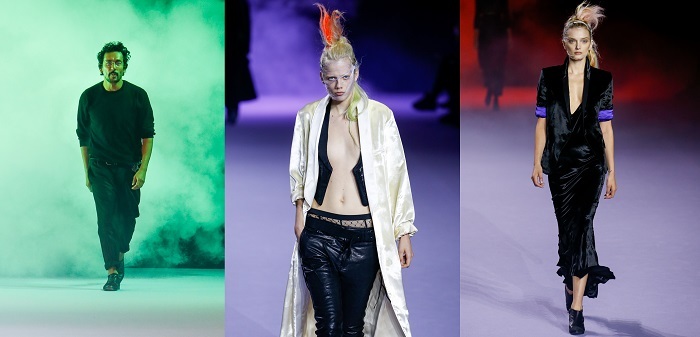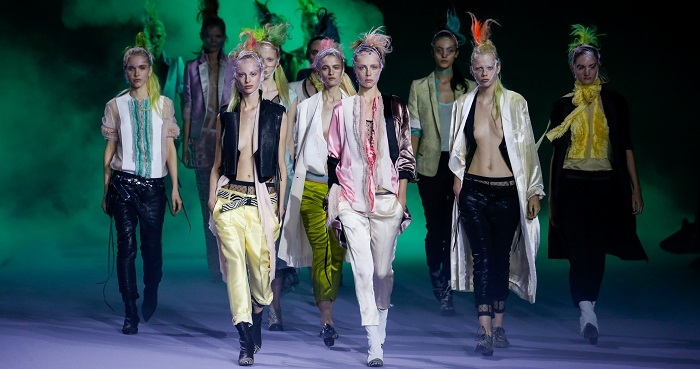

Haider Ackermann, a Colombian designer known for his modern and edgy approach to fashion, was appointed as the Creative Director of Jean Paul Gaultier Couture in 2020. Ackermann's debut collection for Gaultier Couture was showcased in January 2021, blending his signature style with the brand's avant-garde heritage.

Haider Ackermann was born in Colombia in 1971 to a colombian mother and a French father. He spent most of his childhood in Ethiopia, Chad, Algeria, and France before moving to Belgium to study fashion design at the Royal Academy of Fine Arts in Antwerp.
After graduating in 1994, Ackermann worked as an intern for designer John Galliano in Paris. He then moved to Belgium to work for several fashion companies, including Bernhard Willhelm, before launching his eponymous label in 2001.
Ackermann's designs are known for their edgy and modern aesthetic, blending traditional tailoring techniques with unconventional materials and asymmetrical cuts. He has been praised for his use of color and his ability to create fluid silhouettes that flatter the body.
Ackermann has been awarded several accolades for his work in fashion, including the ANDAM Fashion Award in 2005 and the Swiss Textiles Award in 2008. He has also collaborated with several high-profile brands, including Berluti, Maison Margiela, and Dior Homme.
Haider Ackermann's debut collection for Jean Paul Gaultier Couture, showcased in January 2021, was highly anticipated by the fashion industry. The collection blended Ackermann's signature style with the brand's avant-garde heritage, featuring bold colors, intricate details, and unconventional materials.
Many of the garments featured uneven hemlines, unexpected cutouts, and unconventional draping techniques.
The collection showcased a range of textures, including metallics, leather, and silk. Ackermann played with contrast, pairing bold colors with muted tones and incorporating unexpected materials such as PVC und Plastic.
Overall, Ackermann's debut collection for Gaultier Couture was praised for its boldness, creativity, and modernity while staying true to the brand's avant-garde roots. It showcased Ackermann's talent for creating fluid and striking silhouettes while paying homage to Gaultier's legacy.
Haute couture techniques and craftsmanship were key features of Haider Ackermann's debut collection for Jean Paul Gaultier Couture. The collection showcased a high level of craftsmanship and attention to detail, which are hallmarks of the haute couture tradition. One of the most striking aspects of Ackermann's designs was his use of unexpected materials, such as PVC and plastic. These materials were manipulated using traditional couture techniques to create garments that were both innovative and highly detailed. For example, in one design, Ackermann used laser-cut PVC to create intricate lace-like patterns.
The collection also featured a variety of other traditional couture techniques, including embroidery, beading, and appliqué. These techniques were used to add texture and depth to the garments, as well as to create highly detailed embellishments. The level of craftsmanship in Ackermann's designs was also evident in the construction of the garments themselves. Many of the pieces featured asymmetrical cuts, unexpected angles, and unconventional silhouettes, which required a high degree of skill to execute.
Overall, Ackermann's use of traditional haute couture techniques and craftsmanship helped to elevate his designs and create garments that were both beautiful and technically impressive. These elements are sure to continue to be a hallmark of Jean Paul Gaultier Couture under Ackermann's leadership, as the brand continues to push the boundaries of what is possible in the world of high fashion.
Haider Ackermann's debut collection for Jean Paul Gaultier Couture was influenced by a variety of sources, including his own background in fashion and his appreciation for the brand's avant-garde heritage.
One of Ackermann's key inspirations was Jean Paul Gaultier himself. In an interview with Vogue, Ackermann spoke about his admiration for Gaultier's ability to challenge traditional gender norms and create designs that pushed the boundaries of what was considered acceptable in fashion.
He has said that he wanted to bring a fresh perspective to the brand while still honoring its rich history and legacy.
The collection was also inspired by the idea of movement and transformation. Ackermann incorporated elements of asymmetry, unexpected cutouts, and deconstruction to create garments that felt fluid and dynamic.
The collection featured bold colors and unexpected materials, such as PVC and plastic, which added texture and depth to the designs.
Overall, Ackermann's debut collection for Jean Paul Gaultier Couture was influenced by a wide range of sources, reflecting his eclectic and innovative approach to fashion.
The reception to Haider Ackermann's debut collection for Jean Paul Gaultier Couture was generally positive. Critics praised Ackermann's ability to blend his own signature style with the brand's avant-garde heritage, creating a collection that felt both fresh and respectful of the brand's legacy.
Many reviewers highlighted Ackermann's use of asymmetry, unexpected cutouts, and deconstruction as some of the collection's key features.
However, some reviewers noted that the collection felt somewhat disconnected from the world outside of fashion, with its emphasis on extravagance and glamour. Others criticized the lack of diversity among the models in the runway show.
Overall, Ackermann's debut collection for Jean Paul Gaultier Couture received positive reviews, with many critics applauding his ability to infuse the brand with new energy while staying true to its avant-garde roots.

Haider Ackermann's appointment as Creative Director of Jean Paul Gaultier Couture was announced in September 2020, following the brand's decision to stop producing ready-to-wear collections and focus exclusively on couture.
Ackermann's appointment was widely praised by the fashion industry, with many noting that his modern and edgy approach to fashion was a good fit for the brand's avant-garde heritage.
In an interview with Vogue, Ackermann expressed his excitement about the opportunity to lead a couture brand, saying that he had always been drawn to the artistry and craftsmanship of haute couture. He also acknowledged the challenges of creating couture in a time when the fashion industry is facing significant economic and environmental pressures.
Since taking on the role, Ackermann has been working to reimagine the brand's approach to couture, experimenting with new techniques and materials while staying true to the brand's DNA.
Under Haider Ackermann's leadership, Jean Paul Gaultier Couture is expected to continue to explore new techniques and materials while staying true to its avant-garde heritage. Ackermann has expressed his commitment to sustainability and has said that he wants to incorporate more eco-friendly practices into the brand's couture production process.
In addition to his focus on sustainability, Ackermann has also expressed a desire to make the brand more inclusive and diverse. He has said that he wants to create couture that feels relevant and accessible to a wider range of people, while still maintaining its sense of luxury and exclusivity.
As the fashion industry continues to grapple with the effects of the COVID-19 pandemic, Ackermann has also acknowledged the need for the brand to be adaptable and flexible in the face of changing circumstances. He has said that he is open to exploring new formats for presenting couture, such as digital shows or presentations, and that he wants to create collections that can speak to people in a variety of contexts and settings.
Overall, Ackermann's leadership is expected to bring a fresh perspective to the brand, while still honoring its rich history and legacy.
Haider Ackermann's debut collection for Jean Paul Gaultier Couture was a highly anticipated event in the fashion world. The collection was praised for its innovative approach to couture, which blended traditional techniques with modern materials and designs. Ackermann's use of gender fluidity, deconstruction, and unexpected materials created a collection that felt both fresh and timeless, while still honoring the brand's avant-garde heritage. His commitment to sustainability and inclusivity also signaled a new direction for the brand, which has long been known for its bold and daring designs.
Overall, Ackermann's leadership is expected to bring a new energy to Jean Paul Gaultier Couture, while still maintaining the brand's reputation for luxury and exclusivity. As the fashion industry continues to evolve, Ackermann's innovative and forward-thinking approach is sure to make a significant impact on the brand and the wider world of haute couture.